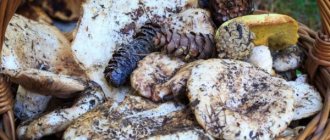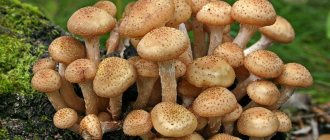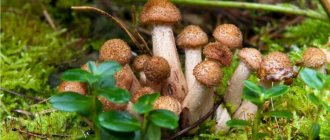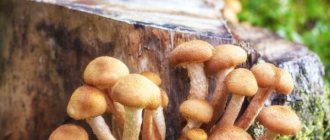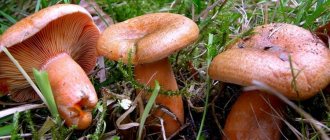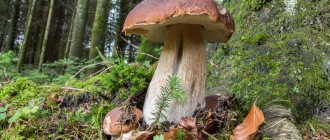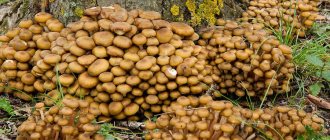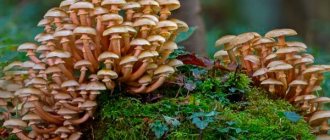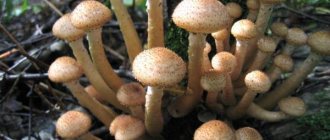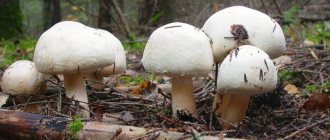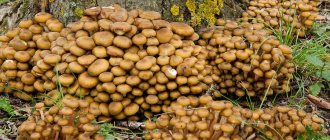Mushrooms
0
3781
Article rating
Kira Stoletova
Honey mushrooms are outwardly inconspicuous, unpretentious mushrooms, but they have excellent taste and are universal in use. They are often grown at home. The growth time of honey mushrooms is short and depends on organized climatic conditions.
How long does honey mushrooms take to grow?
Description of honey mushrooms
Young fruiting bodies have convex caps with small scales. As the cap grows, it becomes flat and wide, and the scales most often disappear. The color of the cap varies from light honey to dark olive. Size 3–17 cm. The leg grows 7–12 cm in height and usually 1–2 cm in girth. Thin and light at the top, widens downward and acquires a dark color. Covered with a coating in the form of flakes.
Young fruiting bodies have a “skirt” on the stem, which disappears over time . Young fruiting bodies have denser pulp. In mature mushrooms, the stem acquires a tough, fibrous texture. The plates, hidden under very young caps, straighten and darken with growth.
What mushrooms can you pick?
Armillaria belongs to the honey mushroom family, widely distributed throughout the world, with the exception of the tropics, Arctic and Antarctic. They grow on coniferous and deciduous trees in the forest, outside the forest, in forest clearings, in parks, meadows and gardens. The host tree gradually dies after a honey fungus infestation, but the dead wood still serves as food for the fungi years later.
They spread underground from tree to tree through widely branched mycelium threads. Since mycelium threads several kilometers long were discovered, this species is considered the largest living organism on earth.
Honey mushrooms grow in large clusters and appear from July to November, but most often in early to mid-autumn. The caps range in diameter from 3 to 15 cm and can be honey yellow, olive green or ocher. At first convex in shape, they have a bare surface dotted with small dark brown scales that are easily washed off by rain.
As the caps age, they become flat and have wavy edges and a dent in the middle.
White or light yellow, later brown and variegated plates merge into a narrow stem that grows up to 15 cm in height and can be reddish-brown or almost black. Just below its tip there is a yellowish cuff. All Armillaria are divided into winter, autumn, summer and meadow.
Armillaria mellea or autumn honey fungus (true)
They grow in dense groups, usually on deciduous wood, but are sometimes found on coniferous wood. The mushroom has a rather bald cap, a strong ring with yellow edges on the stem and fused stem bases that taper towards the ends. The spore print is white.
The cap is 3.5–5 cm, convex, often with square sides when young. With age, it expands to be broadly convex or almost flat. Dry or slightly sticky. Golden yellow when young and fresh, it soon turns yellowish or brown. Flesh: whitish to slightly pink. The smell and taste are not characteristic.
Honey mushrooms grow young, suitable for consumption, in dense groups. The first appearance of autumn honey mushrooms occurs at the end of summer. Numerous fruiting is observed between September and October, but in warm weather they can also be found in December. In total, there are about a dozen different types of edible autumn mushrooms.
- Armillaria gallica (Thick-legged). The autumn mushroom differs from the real one in having a thick stem and fewer individuals in the group. Fruiting dates are evenly distributed between August and October (sometimes starting in July). It is more likely to grow alone or in small clumps rather than in tightly spaced clusters that cause the bases of the stems to become pointed.
- Armillaria borealis (northern). It differs from its autumn counterpart in its light brown color. Appears similar to a true mushroom. Their habitats are also similar.
- Armillaria tabescens (shrinking honey mushrooms). They are also called oak or ringless. Trees with broad leaves are chosen for habitat. Quite often, their clusters are noticed on oak trees, which is why another name appeared - oak honey fungus. This shrinking honey fungus is called by another name due to the absence of a leg ring. This gives it a resemblance to false honey mushrooms. However, by the cap scales you can understand that this is an edible mushroom. Fruiting occurs in July – October (sometimes begins in June).
Kuehneromyces mutabilis (summer honey mushrooms)
These mushrooms are not true, although the similarities, of course, can be noticed. They represent a family with the original name “Kyneromycesses”. But the edibility of the summer honey mushroom is beyond doubt, so it always receives the attention of mushroom pickers. Fruiting begins in April and continues until November.
The article describes the timing when different types of honey mushrooms grow.
The external dimensions of the summer mushroom are slightly smaller than those of the autumn mushroom. It has a cap up to 6 cm and a shorter stem. In addition, its color differs in shades of yellow. The main sign of the summer honey mushroom is the presence of a wide light (sometimes dark) tubercle on the cap.
Flammulina velutipes (winter honey fungus)
Winter honey mushrooms grow on damaged trees. At the same time, they have some external resemblance to the group of true honey mushrooms. In the family of mushrooms they are distinguished as “rows”.
The main feature of winter honey mushroom is the time of growth. In the winter cold, the appearance of false mushrooms is impossible - this is contrary to their nature. It received the name “winter” due to its resistance to low temperatures tending to zero. From the last days of autumn until the onset of spring, fruiting occurs.
Marasmius oreades (meadow honey fungus)
Does not apply to real mushrooms. Its direct relatives are non-rotting mushrooms.
It received its name only for some external resemblance to autumn mushrooms. The fruiting period begins at the end of May and ends at the end of October.
Bulbous honey fungus
Grows on a tree. There is an onion-like thickening at the base. The cap is almost always darker than the stem. The color is usually yellow or bright brown. It grows from late summer to September on old stumps and rotting remains of trees.
Pholiota (royal honey fungus)
This representative of the mushroom kingdom is not a true mushroom. It received this name for its spectacular appearance. It is decorated with a bell-shaped hat on top and is covered with patterned scales, reminiscent of a royal robe. They bear fruit from mid-August until the end of November, and are collected on rotting old trees and stumps in any forest.
How to find honey mushrooms in the forest
Autumn honey mushrooms sprout in any forest from the subtropics to the northern latitudes. You should look for these fruiting bodies near trees in damp places. Strictly speaking, Armillaria is a parasite that lives at the expense of other plants, spreading through spores and mycelium . When honey mushrooms invade, an entire forest can die out. Young birches, oaks and pines, attacked by Armillaria, die especially quickly.
On what trees and stumps are they found?
Most often, Armillaria can be found on dead trees of absolutely any variety, as well as on rotten stumps . Less often - on healthy trees and herbaceous plants, fallen branches. Mushrooms grow in colonies, which is very popular with mushroom pickers. Often their legs grow together at the bottom. They mainly prefer lowlands, where there is a lot of shade and moisture. They appear on the stumps of alder, birch, elm, and aspen 2-3 years after the trees are cut down . They can be seen on oak or pine stumps 8–10 years after the tree was cut down.
How mushrooms appear. About mushrooms and their origin
Yandex.Taxi will launch a cargo transportation service. The new service will provide the opportunity to order cargo transportation at two tariffs. It will also be possible to use the service of a loader. The first tariff allows you to order a passenger car (Citroen Berlingo and Lada Largus) with a cargo compartment with a total carrying capacity of no more than 1 ton. The second tariff includes light-duty vans with a carrying capacity of up to 3.5 tons, for example, Citroen Jumper and GAZelle NEXT. The cars will not be older than 2008, Kommersant reports. Clients will also be able to order transport with loaders, but if the driver works alone, he will not receive such orders. Yandex.Taxi promises “special bonuses for some partners and drivers” who subscribe to the new tariff.
What and how affects the growth of honey mushrooms
The growth of honey mushrooms is influenced by a large number of factors, so it is impossible to clearly determine when you will get the optimal harvest. Experienced mushroom pickers still have their own observations and ideas about how long after precipitation and under what weather conditions it is worth going on a “quiet hunt.”
At what temperature do they grow?
Honey fungus grows at temperatures from +8 to +13°C . When the soil and air warm up to more than +15°C, the mushroom caps disappear. Accordingly, the peak of growth does not occur in any specific month, but is regulated solely by the ambient temperature. When the temperature drops closer to winter, honey mushrooms disappear only as the soil freezes. External cold does not frighten them as long as the mycelium is warm.
How quickly they grow after rain
Armillaria grows on average from a day to a week. The heavier the rain and the more favorable the temperature conditions, the more likely it is that you will find a mushroom harvest in the ravines on rotten stumps.
On average, the growth of the fruiting body per day is 1.5–2 cm. The fruiting bodies of honey mushrooms live up to fifteen days. They stop growing on the eleventh day.
How to stimulate growth?
For the growth of fruiting bodies from the mycelium, it is necessary that the temperature conditions coincide and there is also optimal air humidity (55–60%). Also, mushrooms grow well only in the presence of loose soil saturated with oxygen .
Another factor stimulating rapid growth is a sudden sharp cold snap (down to -10°C) for three to four hours, followed by an ambient temperature of 1 to 5°C during the day. After such temperature fluctuations, the most generous harvests of Armillaria appear.
Processing and consumption
In culinary dishes where honey fungus is used, its legs and caps are needed. Many mushroom pickers prefer those fruits that have a large cap. If the honey fungus is large, then you need to take only its cap; its leg will be stiff.
Overgrown mushrooms found on stumps, or those that were collected after heavy rains, do not have a very attractive appearance, their taste is not the best, but they can be pickled, boiled and fried.
Dried honey mushrooms are a favorite delicacy of many, but not everyone knows how to make them. For drying, you need to take strong, healthy and fresh mushrooms that should not have wormholes. It is not worth washing honey mushrooms that were found on stumps. If you do this, they will dry for a long time, and they will also turn black. Honey mushrooms are simply wiped with a cloth, clearing them of soil, sand, and moss. Large caps are cut into small slices. Only they are used for drying. For this, an oven, gas stove or Russian stove are used. To dry the honey fungus, you will need high temperature and constant air circulation.
If the mushrooms are bitter, then, most likely, the mushrooms got into the basket.
Many people prefer to freeze the product for the winter. Freshly frozen mushrooms can be used to prepare various dishes. How does the freezing process proceed? Initially, you need to sort through the harvested crop, sort it and clear it of debris. Freezing should be done only after complete drying.
To do this, the product is placed on a freezing tray. You should not lay it out in several layers, because this will lead to deformation, and it will take longer to freeze.
Autumn is the best time for mushroom pickers! Admiring the beauty of the autumn forest can be combined with something useful - searching for mushrooms. It is during leaf fall that autumn honey mushrooms appear, one of the most delicious mushrooms for pickling and pickling. Where do they grow and how to distinguish the autumn honey fungus from the false one? We will find out more about this below.
Most often, real honey mushrooms grow on various trees, less often on other plants. They always grow up in huge families, photo:
They live on both coniferous and deciduous trees. But most often in our area they are found on birch and aspen trees. They also grow on old stumps.
From the name of this mushroom it is clear that they grow in the fall. The first autumn honey mushrooms appear already in August and grow until November. You should look for them primarily on fallen trees and old stumps.
Interesting fact: at night you can notice a faint glow of the stump, which is chosen by honey mushrooms. This phenomenon can often be observed before a thunderstorm. It is not the mushrooms themselves that emit a white or faint bluish color, but the mycelium. To see such an extraordinary phenomenon for yourself, you should simply stay overnight near the stump with these mushrooms. A very beautiful sight! About 5-6 years ago, one September day, returning late in the evening from hunting, I saw this phenomenon for the first time. The bluish glow of the stump first brought me into primeval horror, but then I remembered my school lessons about the world around me, when the teacher told me that some mushrooms can glow. It is so mesmerizing that I stood and looked at the glowing honey mushrooms for at least an hour. Unfortunately, photographing this miracle is not so easy - you need a good camera that takes high-quality pictures, and in addition, you need to have the skills to take photographs in the dark. And it is impossible to convey this wonderful phenomenon through an image - you need to see it all yourself.
How to distinguish false honey mushrooms from edible ones
False honey mushrooms grow just like real ones, in colonies on stumps and old trees. At first glance, they can easily be confused with edible fruiting bodies.
However, there are quite a few signs that can help distinguish a false honey fungus from an edible one:
- An adult Armillaria has a rim on its stalk, which is a remnant of the protective film that covered the plates of young fungi.
- False honey mushrooms have a much brighter color (yellow, gray-olive or brick-red) than true ones.
- True Armillaria has cream or slightly brownish plates at the bottom of the cap, while false Armillaria has yellowish-gray plates.
- Edible fruiting bodies have a pleasant smell, while false ones smell unpleasant to humans.
Benefit
These mushrooms contain vitamins B, E, C, and PP. There are useful microelements: iron, phosphorus, zinc, potassium and others. They contain fiber, proteins, amino acids and natural sugar.
Edible honey mushrooms are recommended for consumption by vegetarians, as they allow them to compensate for the lack of phosphorus and potassium due to the lack of protein foods in the diet. For the same reason, mushrooms are recommended for use by people who have problems with bone tissue and as a preventive product against the occurrence of this type of pathology.
Zinc, iron and magnesium have a beneficial effect on the process of hematopoiesis, so they are suitable for nutrition for people with anemia. Only 100 grams of mushrooms contain a daily dose of microelements to maintain normal hemoglobin. These mushrooms have antimicrobial properties; their antiseptic properties can even be compared with garlic.
Traditional medicine uses honey mushrooms to treat diseases of the thyroid gland and liver.
How to collect honey mushrooms correctly
Once you find the Armillaria family, you can easily harvest a large harvest very quickly. In this case, you should follow some collection rules:
- take familiar mushrooms;
- It is best to harvest in the early morning, when the mushrooms are saturated with cool dew, are more elastic and tolerate transportation well;
- give preference to young specimens, they are, as a rule, tastier and not worm-eaten, and also do not have time to absorb many harmful substances;
- when collecting, you need to carefully trim the stem of the fruiting body or unscrew it, trying not to spoil the mycelium;
- the collected product must be laid with its caps down or on its side;
- in its raw form, the harvest is not stored for a long time; it must be processed immediately after arriving home.
Mushroom picking brings real pleasure to connoisseurs of this process. Autumn honey mushrooms have a rich chemical composition. They can not only satisfy hunger, but also satisfy the needs of the most picky gourmets, and also have a healing effect on the body. Guided by the basic rules for collecting Armillaria, you can reap a good harvest and please yourself and your loved ones.
Features of growing honey mushrooms
In nature, honey mushrooms grow in large groups on fallen trees and stumps, i.e. on dead wood, although they can also settle on living but weakened trees.
- These are “hemp” mushrooms that actively reproduce on moistened wood of deciduous trees. They do not germinate on rotten wood. This method of growing on logs or stumps is also practiced at home. Mycelium grows with proper care in a greenhouse
- Growing honey mushrooms in glass jars.
- If there are freshly cut trees in the garden plot, it is better to choose the main method of cultivation and not risk future honey mushrooms. If not, sprouting mycelium in a jar will do. The fruiting body of the mushroom or a piece of wood where they sprouted earlier (it contains mycelium) is used as planting material.
- The time for growing mycelium on stumps (or with other methods of maintenance) depends on weather conditions. Usually they go to the forest to pick mushrooms after the rain, expecting to get a rich harvest. In artificially organized conditions, the climate created by the owner of the “mushroom bed” also plays a big role.
Irina Selyutina (Biologist):
Having chosen stumps left over from cut down trees and still growing as the basis for growing honey mushrooms, you will have to periodically water the ground around them after colonizing the mycelium.
If you decide to opt for logs, then in the case of logs that were cut down a long time ago, they will have to be soaked before planting the mycelium. Then such logs will need to be placed in the basement, where a constant temperature is maintained at +15…20℃ and covered with straw. Since a high level of humidity is required, you will need to wipe the floors and walls several times a day or provide a sufficient number of containers with water. As soon as the logs are overgrown with mycelium, they need to be taken out to the site and buried in the place chosen for this. The very next year you will receive the first harvest of honey mushrooms. The collection will continue until the stump or log is completely “destructed”.
The more precise and better the growing conditions are, the faster the growth rate will be. The average readiness of mycelium for harvesting is 7-8 days.
Dependence of mushroom growth on air temperature
Mushroom growers often rely on air temperature in their practice. Reproduction of mycelium planted on a stump begins already at a temperature of +3...+4°C (spores of winter, autumn and spring honey mushrooms germinate). The mushroom grows under such conditions for up to 30 days. The germination rate changes in the presence of systematic jumps (differences) in night and day temperatures.
A favorable indicator for the active growth of mycelium is usually within the range of +16...+26°C. Without temperature changes and high humidity, summer and autumn varieties of mushrooms are able to grow and complete the period of active growth in just 8-9 days. If the temperature is higher than the upper limit, the germination rate will slow down.
Irina Selyutina (Biologist):
A mushroom grower should never forget that the mycelium absorbs all nutrients by osmosis, and chemical reactions in the cells of the fruiting body occur only at certain temperatures. Air humidity in the ground layers is extremely important for mushrooms. Fruiting (spore-bearing) bodies are formed when the air humidity in the ground layers is at least 50-60%, because their body lacks structures that protect fungal cells from excess moisture evaporation. Therefore, very often mushroom pickers and mycologists say that the growth of mushrooms (fruiting bodies) stops in the event of a sudden onset of drought, even if this happened after a rainy period and there seemed to be plenty of soil moisture. But the air in the ground layer is dry and, as a result, the fruiting body of the mushroom dries out. In this case, experienced mushroom pickers look for mushrooms under moss or in the forest floor.
When the thermometer exceeds +30°C, the honey fungus quickly deteriorates, especially if there is drought during the period of its development.
Growth of honey mushrooms in the forest
Temperature is important for mushroom growth
Meadow honey mushrooms (they are also called “wild honey mushrooms”) sprout on stumps. For active growth, they need a temperature of +20...+23°C (summer) and +10...+12°C (autumn and spring). For rapid ripening of fruiting bodies, high humidity of the wood and the surrounding air is also important. Both autumn and spring and summer honey mushrooms require an optimal combination of heat and moisture for rapid development.
Assumption honey mushrooms or bulbous
Partly summer and partly autumn honey mushrooms with the beautiful name of the subspecies - “Assumption”, begin to bear fruit after the Orthodox holiday - “Assumption of the Blessed Virgin Mary”, which falls on August 28 according to the new calendar.
Like the summer subspecies, the autumn ones have the ability to begin germination one to two weeks earlier or later from the approximate date. Therefore, in order to save your free time and energy, you should go searching after the heat subsides at night and the beginning of rains, combined with the warm rays of the sun.
Bulbous plants most often occur at the base of stumps and on the leaf cushion. The best chance of finding this subspecies is in oak deposits.
Germination rate of autumn mushrooms
Autumn mushrooms, collected in September and early October, are the most popular among mushroom pickers, as they contain in their fruiting bodies a large number of compounds useful for humans. It's the start of the rainy season, but the weather is still warm outside. This period is considered the most productive time for collecting mushrooms.
In autumn, honey mushrooms grow most quickly: from late August to mid-October, the mycelium grows in just 8 days. In the event of heavy rain, it takes even less time to grow. The fruiting body is suitable for cutting already on the 4-5th day.
Autumn honey mushrooms have different growth rates, depending on the condition of the wood. On old and rotten wood, mycelium grows faster, because this wood, due to its characteristics, absorbs moisture more easily. In just a day, their number often doubles, and a new, young mushroom, after 24 hours, will have a leg 4-5 cm long and a cap 2-2.5 cm in diameter. The maximum growth of this mushroom reaches 14 cm at the cap size is 8-9 cm. If the mushroom exceeds this size, most likely it is a representative of false mushrooms.
Mushrooms collected later, at the end of October - beginning of November, are considered winter. Compared to autumn honey mushrooms, winter honey mushrooms grow more slowly and only in those regions where the climate is mild and warm. Favorable conditions for the germination of the last crops of the year will be the absence of frost and the temperature range from +6°C to +10°C
When does the mushroom season begin and end?
The autumn honey mushroom season, as a rule, begins in August and ends in November with the onset of frost . Frozen mushrooms become soft and watery, lose their taste and aroma and are no longer of interest to mushroom pickers. The beginning and end of the growth of Armillaria depends on climatic and weather conditions in each specific season.
Time and conditions for the growth of honey mushrooms in the forest
But before getting to our table, honey mushrooms still need to be found in the forest. Many people are familiar with where and how to collect these fruiting bodies. However, few people know about the growth time of honey mushrooms. So, if we take into account that all honey mushrooms are divided into spring, summer, autumn and winter species, then their growth affects the corresponding seasons. However, this is just general information and is unlikely to be of much use. You need to know how quickly honey mushrooms grow in the forest, and what weather will be favorable for this. Guided by this information, you can significantly increase not only the quality, but also the quantity of the harvested mushroom harvest.
The best time to collect different types of mushrooms is in summer and autumn
The first mushrooms appear in April, but May is considered the official opening month of the mushroom season. Usually mushroom hunting lasts until October inclusive. But if weather conditions are favorable, new mushrooms grow in November and even in December.
It is better to harvest according to the mushroom calendar. Based on his data, the mushroom picker is less likely to run into an inedible double. The following table details the entire growth period of certain edible species.
| Species name | May | June | July | August | September | October |
| Porcini | + | + | + | + | + | |
| Valuy | + | + | + | + | + | |
| Volnushka | + | + | + | + | + | |
| Volnushka white (Belyanka) | + | + | ||||
| Gorkushka | + | + | + | + | ||
| Gruzd | + | + | + | + | ||
| Raincoat | + | + | + | + | + | |
| Greenfinch | + | + | + | |||
| Kozlyak | + | + | + | + | ||
| Cap | + | + | + | + | ||
| Chanterelle | + | + | + | + | + | |
| Oiler | + | + | + | + | + | |
| Mosswort | + | + | + | + | ||
| Honey fungus | + | + | + | |||
| boletus | + | + | + | + | + | + |
| Boletus | + | + | + | + | ||
| Ryzhik | + | + | + | + | ||
| Ryadovka | + | + | + | |||
| Serushka | + | + | + | + | ||
| Violin | + | + | + | |||
| Morel | + | |||||
| Russula | + | + | + | + | + | + |
| Champignon | + | + | + | + |
The first harvest is much smaller than the harvest collected during the period of active mushroom growth. The following provides data on the peak growth activity of certain edible species.
| Species name | May | June | July | August | September | October |
| Porcini | + | + | ||||
| Valuy | + | + | ||||
| Volnushka | + | |||||
| Volnushka white (Belyanka) | + | |||||
| Gorkushka | + | + | + | |||
| Gruzd | + | + | ||||
| Raincoat | + | + | ||||
| Greenfinch | + | + | ||||
| Kozlyak | + | + | + | |||
| Cap | + | + | ||||
| Chanterelle | + | + | ||||
| Oiler | + | + | ||||
| Mosswort | + | |||||
| Honey fungus | + | + | ||||
| boletus | + | + | ||||
| Boletus | + | + | + | |||
| Ryzhik | + | + | ||||
| Ryadovka | + | |||||
| Serushka | + | + | ||||
| Violin | + | + | ||||
| Morel | + | |||||
| Russula | + | + | + | + | ||
| Champignon | + | + | + | + |
An interesting fact is that during Indian summer you can find varieties from all seasons of the year. And after it, mushroom pickers can only collect the remains of the autumn harvest and winter honey mushrooms.
What weather is needed for mushroom growth: optimal temperature
Everyone knows that honey mushrooms grow in large colonies, settling on rotten stumps and fallen trees. To meet such a friendly “family” on your way is real luck. However, it happens that when we come to the forest, we come across a meager harvest of overgrown honey mushrooms. Most likely, this is due to unsuitable weather conditions, as well as the choice of the wrong time to go for fruiting bodies. In this case, you need to know what kind of weather is needed for honey mushrooms to grow. Such information will help you determine as accurately as possible when you should go on a “silent hunt.”
What temperature is considered optimal for the growth of honey mushrooms in the forest? It must be said that temperature is one of the most important factors affecting the growth of fruiting bodies. Thus, for most mushrooms, including some types of honey mushrooms, the average temperature for abundant growth and fruiting is +15-26°C. However, spores of autumn, spring and winter honey mushrooms begin to grow already at a temperature of +3-5°C. But high air temperatures have a negative effect on the growth of fruiting bodies. So, at +30°C and above, the growth process stops completely, and if there is also drought, the mushrooms begin to dry out and deteriorate. In addition, sharp and strong fluctuations in day and night temperatures also greatly slow down the growth of honey mushrooms.
Conditions for the growth of spring, summer and autumn honey mushrooms in the forest (with video)
We can say that for summer mushrooms the most suitable air temperature is +23°C, and for autumn and spring mushrooms – +12°C. However, these are not all weather conditions that allow abundant fruiting of mushrooms. So, we smoothly moved on to, perhaps, the most important condition necessary for the growth of honey mushrooms in the forest. Good humidity combined with optimal air temperature creates excellent soil for “rich” harvests of these fruiting bodies. It often happens that honey mushrooms can bear fruit abundantly as many times as there are heavy rains during the season.
For the growth and development of the mycelium, regular air flow is also needed. In most cases, the mycelium passes through the upper layers of the soil and deepens to 6-13 cm. If unfavorable weather sets in - severe drought, frost, hardening of the soil, excessive humidity, then it begins to develop poorly and becomes dehydrated, but this does not affect its stability. For optimal growth and development of honey mushrooms, air humidity in the upper layers of the soil should be from 50 to 65%.
Thus, it becomes obvious that favorable weather for honey mushroom growth includes warmth and moisture. What can you say about the growth rate of honey mushrooms? Unfortunately, there is no clear answer to this question, because the process is influenced by a number of factors. Even experienced mushroom pickers are not able to give specific numbers.
We often use the phrase “grow like mushrooms” in our speech. As you can see, this process goes quite quickly. It is noteworthy that the growth of the stem of the fruiting body stops 1-2 days earlier than the growth of the cap. Unfavorable weather, as well as the presence of insects or worms, significantly weaken the growth of mushrooms.
Summer honey fungus
This mushroom, despite its considerable similarity, has nothing to do with real honey mushrooms. This is a representative of fungi with the unpronounceable name “Kyneromyces”. However, it is quite edible and is collected just as actively.
It grows on damaged living trees, but prefers rotten wood, and not just any wood, but deciduous wood (although sometimes this fungus is also observed on coniferous trees).
Summer honey fungus bears fruit virtually throughout the warm season - from April to November (and in countries with a mild climate - all year round).
The size of the fruiting bodies of the summer honey fungus is slightly different than that of the autumn one - the cap does not grow more than 6 cm in diameter, the leg is also three centimeters shorter. The color is somewhat lighter, more yellowish. The main difference is a wide tubercle on the cap, very noticeable - usually light, but sometimes dark. In addition, the caps of summer honey mushrooms are often smooth, and if they have scales, they are light.
This mushroom has a poisonous “double” (which will be discussed below in the chapter on the distinctive features of edible mushrooms from false and poisonous ones), so only experienced mushroom pickers collect it.
The growth period of autumn mushrooms: how quickly mushrooms grow in September after cutting
Among all types of honey mushrooms, autumn ones are considered the most popular. These fruiting bodies also have their own favorable “atmosphere” for active fruiting. Many mushroom pickers love to collect these mushrooms, because in terms of taste they belong to category 3. They make very tasty and aromatic dishes, as well as preparations for the winter. So, the period of growth of autumn mushrooms covers the last days of August, continues throughout September and ends in mid-October. The peak of growth is observed precisely in September with the onset of the first rains.
Many people are interested in how quickly honey mushrooms grow in September, so as not to “miss” the moment of going to the forest? It must be said that autumn honey mushrooms grow even faster than representatives of other species. If the remaining fruiting bodies reach large sizes in 9-12 days, then autumn honey mushrooms mature in 6-8. However, the rate of mushroom growth in autumn also depends on a number of factors. For example, for abundant growth, favorable weather is required - an average temperature of +12°C (small differences in day and night indicators are allowed), as well as moderate rains. In addition, the condition of the stump or tree also affects growth and fruiting. So, if the wood is completely rotten, then the growth rate of honey mushrooms increases. The fact is that such stumps open up a greater flow of air and moisture, which means the mushrooms grow faster.
Many experienced mushroom pickers note that autumn honey mushrooms are ready for collection in 1.5-3 days. If today you find a stump where you can barely see them, then feel free to come to this place tomorrow. The fruiting bodies will be ready to go into your basket. In addition, autumn species of honey mushrooms also reproduce quite quickly. Within a day, you can find a large number of representatives of the mushroom “kingdom” on an empty stump or tree. Mycological specialists note that already on the second day, the autumn honey fungus reaches 5 cm in length, and the diameter of the cap is about 2 cm. After another 2-3 days, these figures increase by 1.5 cm. Then the leg slows down in growth, and the cap continues grow. On the last day of life of the honey fungus (10th day), the leg reaches 9-14 cm in height, and the cap has a diameter of more than 8 cm.
Some lovers of “quiet hunting” ask how quickly honey mushrooms grow after cutting? Here you can also wait 2-3 days and again go to the place where you have already harvested.
It must be said that all mushrooms, having completed fruiting, begin to age and decay the very next day. This process occurs very quickly, but autumn species have an advantage in this case. They age more slowly, maintaining their elasticity and fleshiness longer. This is due to cool weather as well as sufficient humidity.
Duration of the mushroom period for different species
In warm, sunny weather, many new mushrooms appear in the forest after a good rain. In order to determine the mushroom age, it is enough to simply know the duration of the growth period of certain species.
The most common types of Russia have the following growth periods:
- porcini mushrooms reach large sizes already 2-3 days after warm rain;
Most species grow in 3 to 5 days. Full ripening usually occurs on the 10th day. It is noteworthy that fungal organisms grow equally actively both during the day and at night, without wasting time on rest. As autumn approaches, growth slows down. This is due to a decrease in air temperature.
How quickly do honey mushrooms grow in the fall after rain?
How quickly do honey mushrooms grow in the fall after rain? In this case, the first 2-3 days after the last drop falls on the soil are the most suitable for going to the forest. It has been established that the highest growth rate of honey mushrooms occurs precisely in the first days after rain. Keeping this in mind, you will be able to correctly calculate the time when you can go into the forest for a new harvest.
In addition, another favorable phenomenon for the growth of autumn mushrooms is fogs, which can be observed throughout September and October. Frequent fogs also have a very beneficial effect on the “richness” of mushroom harvests, because the soil is saturated with a sufficient amount of moisture. In this case, he recommends planning a trip to the forest early in the morning, when the sun has not yet had time to illuminate it with direct rays.
Recent Research Results
Employees of the University of Miami recently discovered a real pattern between rain and the appearance of mushrooms. It turns out that the released spores have the property of accumulating in moist air and forming clouds. And when it rains, they, along with its drops, fall back to the ground. This expands the fungal habitats occupied by individual species. Plus, sediments saturated with fungal spores stimulate the rapid growth and development of these living organisms.
Moreover, it has been proven that precipitation is a factor stimulating the formation and release of the spores themselves.
